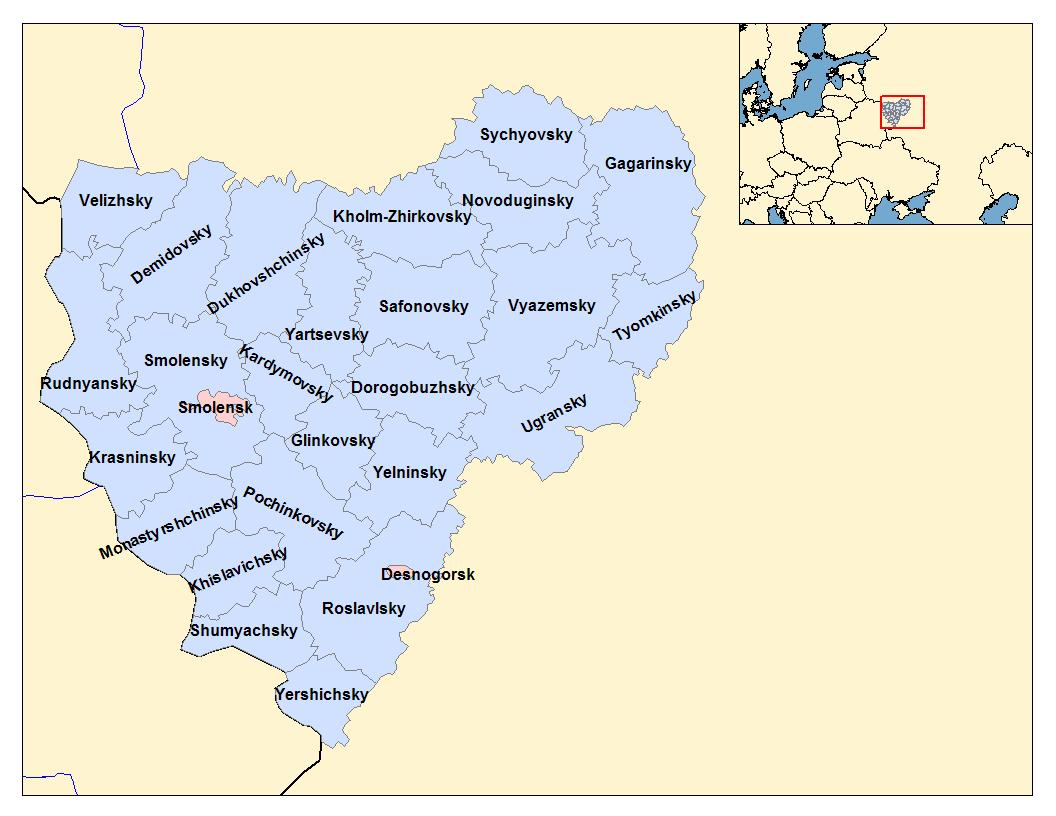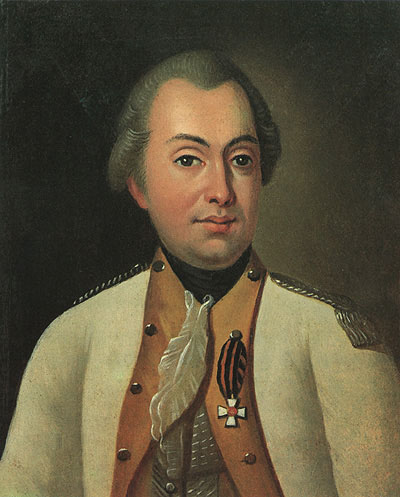|
Yelnya, Yelninsky District, Smolensk Oblast
Yelnya () is a town and the administrative center of Yelninsky District in Smolensk Oblast, Russia, located on the Desna River, from Smolensk, the administrative center of the oblast. The population was Etymology Yelnya's name is likely related to the Russian word ""('yel''', lit. '' fir tree'') or "" (''yelan''', lit. ''land cleared from forest''). History It was first mentioned in the historical documents in 1150 when according to the order of knyaz Rostislav of Smolensk it was to pay a tax of four grivnas and a fox skin. The settlement shared the history of the Smolensk lands—it paid duty to the Golden Horde, then was captured by the Grand Duchy of Lithuania and the Polish–Lithuanian Commonwealth. It was returned to Russia with the rest of the Smolensk Voivodeship at the close of the Russo-Polish War of 1654–1667. In 1776, it was granted town status and became the seat of an uyezd. In 1812, during the French invasion of Russia, Yelnya became an important ... [...More Info...] [...Related Items...] OR: [Wikipedia] [Google] [Baidu] |
Smolensk Oblast
Smolensk Oblast (), informally also called Smolenshchina (), is a federal subjects of Russia, federal subject of Russia (an oblast). Its administrative centre is the types of inhabited localities in Russia, city of Smolensk. As of the 2021 Russian census, 2021 Census, its population was 888,421. Geography The oblast was founded on 27 September 1937.Исполнительный комитет Смоленского областного совета народных депутатов. Государственный архив Смоленской области. "Административно-территориальное устройство Смоленской области. Справочник", изд. "Московский рабочий", Москва 1981. Стр. 8 It borders Pskov Oblast in the north, Tver Oblast in the northeast, Moscow Oblast in the east, Kaluga Oblast in south, Bryansk Oblast in the southwest, and Mogilev Region, Mogilev and Vitebsk R ... [...More Info...] [...Related Items...] OR: [Wikipedia] [Google] [Baidu] |
Uyezd
An uezd (also spelled uyezd or uiezd; rus, уе́зд ( pre-1918: уѣздъ), p=ʊˈjest), or povit in a Ukrainian context () was a type of administrative subdivision of the Grand Duchy of Moscow, the Tsardom of Russia, the Russian Empire, the Russian SFSR, and the early Soviet Union, which was in use from the 13th century. For most of Russian history, uezds were a second-level administrative division. By sense, but not by etymology, ''uezd'' approximately corresponds to the English "county". General description Originally describing groups of several volosts, they formed around the most important cities. Uezds were ruled by the appointees (''namestniki'') of a knyaz and, starting from the 17th century, by voyevodas. In 1708, an administrative reform was carried out by Peter the Great, dividing Russia into governorates. The subdivision into uyezds was abolished at that time but was reinstated in 1727, as a result of Catherine I's administrative reform. By the USSR administra ... [...More Info...] [...Related Items...] OR: [Wikipedia] [Google] [Baidu] |
Soviet Partisans
Soviet partisans were members of Resistance during World War II, resistance movements that fought a Guerrilla warfare, guerrilla war against Axis powers, Axis forces during World War II in the Soviet Union, the previously Territories of Poland annexed by the Soviet Union, Soviet-occupied territories of interwar Poland in 1941–45 and eastern Finland. The activity emerged after Nazi Germany's Operation Barbarossa was launched from mid-1941 on. It was Central Headquarters of the Partisan Movement, coordinated and controlled by the Soviet government and modeled on that of the Red Army. The partisans made a significant contribution to the war by countering German plans to exploit occupied Soviet territories economically, gave considerable help to the Red Army by conducting systematic attacks against Germany's rear communication network, disseminated political rhetoric among the local population by publishing newspapers and leaflets, and succeeded in creating and maintaining feelings ... [...More Info...] [...Related Items...] OR: [Wikipedia] [Google] [Baidu] |
Great Patriotic War
The Eastern Front, also known as the Great Patriotic War (term), Great Patriotic War in the Soviet Union and its successor states, and the German–Soviet War in modern Germany and Ukraine, was a Theater (warfare), theatre of World War II fought between the European Axis powers and Allies of World War II, Allies, including the Soviet Union (USSR) and Polish Armed Forces in the East, Poland. It encompassed Central Europe, Eastern Europe, Northern Europe, Northeast Europe (Baltic states, Baltics), and Southeast Europe (Balkans), and lasted from 22 June 1941 to 9 May 1945. Of the estimated World War II casualties, 70–85 million deaths attributed to World War II, around 30 million occurred on the Eastern Front, including 9 million children. The Eastern Front was decisive in determining the outcome in the European theatre of World War II, European theatre of operations in World War II, eventually serving as the main reason for the defeat of Nazi Germany and the Axis ... [...More Info...] [...Related Items...] OR: [Wikipedia] [Google] [Baidu] |
Oryol Oblast
Oryol Oblast (), also known as Orlovshchina (), is a federal subjects of Russia, federal subject of Russia (an oblast). Its administrative center is the types of inhabited localities in Russia, city of Oryol. Population: Geography It is located in the southwestern part of the Central Federal District, in the Central Russian Upland. In terms of area, at it is one of the smallest federal subjects. From north to south, it extends for more than , and from west to east—for over . It borders Kaluga Oblast to the north-west, Tula Oblast to the north, Lipetsk Oblast to the east, Kursk Oblast to the south, and Bryansk Oblast to the west. There are of black earth soils (chernozems) in the oblast, which amounts to three-quarters of the world chernozem reserves. Climate The climate is temperate (Köppen climate classification, Köppen: Humid continental climate#Warm summer subtype, ''Dfb''). The winter is moderately cold, with an average January temperature from . Summers are w ... [...More Info...] [...Related Items...] OR: [Wikipedia] [Google] [Baidu] |
Western Oblast
Western Oblast () was an administrative-territorial unit (''oblast'') of the Russian SFSR from 1929 to 1937. Its seat was in the city of Smolensk. The oblast was located in the west of European Russia, and its territory is currently divided between Bryansk, Kaluga, Pskov, Smolensk, and Tver Oblasts. According to the 1937 Soviet census, the population of the oblast was 4,693,495 persons. It was abolished on 27 September 1937. History The oblast was established on 1 October 1929 by the All-Russian Central Executive Committee. The territory of the oblast was formed from Smolensk and Bryansk Governorates, parts of Moscow, Kaluga, and Tver Governorates, as well as Velikiye Luki Okrug of Leningrad Oblast. The oblast was subdivided into eight administrative districts (''okrugs''), * Bryansk Okrug (with the seat located in Bryansk); *Klintsy Okrug (Klintsy); *Roslavl Okrug (Roslavl); *Rzhev Okrug (Rzhev); *Smolensk Okrug (Smolensk); *Sukhinichi Okrug (Sukhinichi); *Velikiye Luki Ok ... [...More Info...] [...Related Items...] OR: [Wikipedia] [Google] [Baidu] |
Smolensk Okrug
Smolensk is a types of inhabited localities in Russia, city and the administrative center of Smolensk Oblast, Russia, located on the Dnieper River, west-southwest of Moscow. First mentioned in 863, it is one of the oldest cities in Russia. It has been a regional capital for most of the past millennium, beginning as the capital of an Principality of Smolensk, eponymous principality in the 11th-15th centuries, then the Smolensk Voivodeship of Grand Duchy of Lithuania, Lithuania and Polish–Lithuanian Commonwealth, Poland, and Smolensk Governorate and Oblast within Russia. It was the main stronghold of the Smolensk Gate, a geostrategically significant pass between the Daugava and Dnieper rivers, and as such was an important point of contention in the struggle for dominance in Eastern Europe, passing at various times between Lithuania, Poland and Russia. In more recent history, it was captured by Napoleon's Franco–Polish forces and Hitler's Germany during their marches towards Mo ... [...More Info...] [...Related Items...] OR: [Wikipedia] [Google] [Baidu] |
Vyazemsky Uyezd
Vyazemsky Uyezd (''Вяземский уезд'') was one of the subdivisions of the Smolensk Governorate of the Russian Empire. It was situated in the northeastern part of the governorate. Its administrative centre was Vyazma. Demographics At the time of the Russian Empire Census of 1897, Vyazemsky Uyezd had a population of 105,502. Of these, 98.3% spoke Russian, 0.6% Polish, 0.5% Yiddish, 0.1% Latvian, 0.1% German, 0.1% Ukrainian and 0.1% Tatar Tatar may refer to: Peoples * Tatars, an umbrella term for different Turkic ethnic groups bearing the name "Tatar" * Volga Tatars, a people from the Volga-Ural region of western Russia * Crimean Tatars, a people from the Crimea peninsula by the B ... as their native language. Демоскоп Weekly - Приложение. Справочник статистических показателей [...More Info...] [...Related Items...] OR: [Wikipedia] [Google] [Baidu] |
Roslavlsky Uyezd
Roslavlsky Uyezd () was one of the subdivisions of the Smolensk Governorate of the Russian Empire. This uyezd was situated in the southern part of the governorate. Its administrative centre was Roslavl. Demographics At the time of the Russian Empire Census of 1897, Roslavlsky Uyezd had a population of 188,244. Of these, 97.8% spoke Russian, 1.3% Yiddish, 0.5% Polish, 0.2% Latvian, 0.1% German German(s) may refer to: * Germany, the country of the Germans and German things **Germania (Roman era) * Germans, citizens of Germany, people of German ancestry, or native speakers of the German language ** For citizenship in Germany, see also Ge ... and 0.1% Belarusian as their native language. Демоскоп Weekly - Приложение. Справочник статистических показателей References [...More Info...] [...Related Items...] OR: [Wikipedia] [Google] [Baidu] |
Smolensky Uyezd
Smolensky Uyezd (''Смоленский уезд'') was one of the subdivisions of the Smolensk Governorate of the Russian Empire. It was situated in the central part of the governorate. Its administrative centre was Smolensk. Demographics At the time of the Russian Empire Census of 1897, Smolensky Uyezd had a population of 145,155. Of these, 91.1% spoke Russian, 3.1% Yiddish, 2.6% Polish, 1.2% Belarusian, 0.7% Ukrainian, 0.5% Latvian, 0.4% German German(s) may refer to: * Germany, the country of the Germans and German things **Germania (Roman era) * Germans, citizens of Germany, people of German ancestry, or native speakers of the German language ** For citizenship in Germany, see also Ge ..., 0.1% Tatar, 0.1% Lithuanian and 0.1% Romani as their native language. Демоскоп Weekly - Приложение. Справочник стат� ... [...More Info...] [...Related Items...] OR: [Wikipedia] [Google] [Baidu] |
Mikhail Kutuzov
Prince Mikhail Illarionovich Golenishchev-Kutuzov-Smolensky (; – ) was a Field Marshal of the Russian Empire. He served as a military officer and a diplomat under the reign of three Romanov monarchs: Empress Catherine II, and Emperors Paul I and Alexander I. Kutuzov was shot in the head twice while fighting the Turks (1774 and 1788) and survived the serious injuries seemingly against all odds. He defeated Napoleon as commander-in-chief using attrition warfare in the Patriotic war of 1812. Alexander I, the incumbent Tsar during Napoleon's invasion, would write that he would be remembered amongst Europe's most famous commanders and that Russia would never forget his worthiness. Early career Youth Mikhail Kutuzov was born in Saint Petersburg on 16 September 1745. His father, Lieutenant-General (1717–1784), had served for 30 years with the Corps of Engineers, had seen action against the Turks and served under Peter the Great. His mother was Anna Illarionovna Beklemishe ... [...More Info...] [...Related Items...] OR: [Wikipedia] [Google] [Baidu] |





